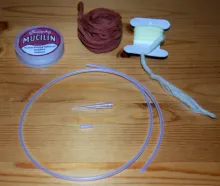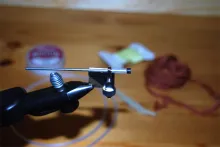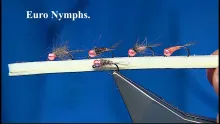Norwegian Geir Kjensmo has developed a strike indicator with the aim of reducing wind resistance and making easy depth adjustments. As a bonus with these indicators can be fished on very long leaders without the indicator stopping in the top ring of your rod when trying to land a fish.
When it comes to fishing with a single hand rod, I’m afraid I’m something of a dry fly purist!
Well, precision casting stone fly nymphs to big browns or rainbows I’ve stalked in those gin clear New Zealand rivers, don’t however give me sleepless nights!
I live in Norway in the small city of Elverum, in my mind the grayling capitol of Europe, and fly fishing for grayling is an activity for me all year. Cold winters in Norway, you think? Well due to the global warming, winters are not that cold anymore. Elverum is situated on the banks of river Glomma and this river with all her tributaries gives us enormous opportunities for grayling. One of the tributaries, river Rena, is regulated with the big and deep lake Storsjöen as a basin. This gives a higher water temperature in the river flowing out of this lake. This alsp influences river Glomma from the conjunction with river Rena down to the city of Elverum.
So, from my home, I only have to travel a couple of kilometres to fish for grayling all year.
I experience dry fly action from late March to the beginning November, but the rest of the year I only see dry fly action on calm, sunny days. Other days and in the winter, I bite the grass and fish with nymphs!
The Czech or Polish nymph technique is very popular and widespread now, but after a couple of winter seasons practising this, I’m not happy: To lob a jiggle of 2-3 heavy nymphs in the water, don’t involve any fly casting and you would probably do better with a long bait fishing rod! Well, the method is effective, but the reminiscence of competition fishing gives me a bad taste in the mouth.
There are a couple of other very good methods to succeed in nymph fishing.
Last two seasons, I’ve been an advocate of using micro-nymphs, size 16-20 Knapek barbless hook tied with material and micro tungsten bead, very thin fluorocarbon leader and either a well impregnated dry fly as indicator or my new strike indicators.
The dry fly patterns like Rackelhanen, Streaking Caddis, Goddard's Sedge and Elk Hair Caddis, work very well in more shallow water and as a bonus, an occasional grayling will pick the dry instead of the micro nymph!
I tie the thin leader from the hook bend of the dry fly to the nymph, NZ-style. Of course, it’s time consuming to adjust the depth with this method.
In the cold period of the season, you’ll find grayling grouped in deeper, slow flowing areas, and to reach these fish with the relatively light micro nymphs, I use a long piece of thin, 0.12-0.10mm, fluorocarbon leader (tippet). The length of thin leader between indicator and nymph is 1.5 times the expected water depth.
You will find some very good yarn indicators made with o-rings here on GFF, and I’ve used these a couple of times. However I experience problems with them. They tend to slide out of position and when I put the loop two times trough the o-ring to stop this, it curls the leader, looks bulky and are not easily adjustable.
My development of strike indicators will be presented here. The development has the aim of reducing wind resistance, making easy depth adjustments. A bonus with these indicators, is the fact that you can fish with very long leaders, or rather long length between indicator and nymph, without experience of indicator stopping in the top ring of your rod when trying to land the fish. This indicator will slide down your leader when you hook up.
Things you need: good poly yarn (choice of your colour), salmon fly plastic tube material (like the Frödin system), a good floatant and a thin plastic pipette or similar.
The latter, you can get from the chemist. The idea is to have a conical thin plastic tube, so maybe you find other materials to serve this purpose too.
Cut a short, 5-8mm, piece from the salmon fly tube material and fix it in your fly tying wise as you would tying a salmon tube.
Tie in poly yarn in the volume of your choice; more yarn in heavier lifting indicators.
Whip finish and secure the “head” with Bison Vinyl Plastic, Zap-A-Gap or similar instead of head cement for better durability.
Cut down the plastic cone so it will easily fit in the tube of the indicator, and also cut some from the tip to allow thicker butts of leaders to pass. Then impregnate; red Mucilin is my favourite! It is designed to make silk-lines float so...
To fix the indicator on the leader you need to put your leader through the indicator and then the plastic cone, before you tie your nymph on.
Then, make a simple loop between indicator and cone, before fixing the cone inside the indicator. This way you lock the indicator on your leader at the desired length between indicator and nymph.
The brilliant thing is that when you hook a fish and the leader tightens. The leader will then release the indicator and indicator and cone will slide down the leader. This will prevent problems when fishing with long leaders and landing fish.
Well, this way I find enjoyment in fly fishing for grayling all year and teamed up with moderate heavy nymphs, these indicators are a pleasure to make a proper fly cast with!
Foam
If you tie the indicator with foam in stead of yarn, you will get more lifting power for heavier nymphs.
Cut narrow strips of a closed cell foam in one or several bright colors and tie them to the tube, letting them flare out slightly. Use the foam indicator exactly as the yarn one.
- Log in to post comments





















Simplified
Hi all!
Due to some people finding the plastic cones hard to get, I've simplified the indicator a lot:
take a look here. Best regards
Geir
Compared
Hi Geir
The indicator compared to the various I found in South Africa is quite different . I will try this on the Vaal river this weekend .
Thanx for the info
Theo
No extra mono
Colin,
There is no extra piece of mono. The loop is formed by the leader itself. It's best seen on this picture.
Martin
Don't quite understand
Hi, I don't quite underrstand where that loop comes from. Is it a seperate piece of monofilament? Sorry, I just cant tell from the pics. Thank you in advance. Colin
Answer to a prayer
Hi Geir,
This looks like an answer to a maidens prayer, though I am no Maid but a 70 yr old duffer still trying to catch trout all year round. I too have tried a number of indicators (and even long 5 m bait rods) to present a perfect drift with a nymph. I actually have some ledger stops from the UK which will be just the job to make a few of your indicators up on. I look foreward to trying them out on a trip to the Clutha River (New Zealand) after Easter.
Tony
Might release
Hi Brian!
Casting with three heavy nymphs might release the cone and as a result, indicator slides down.
However with a perfect fitting cone and the indicator built on a softer tube, you are able to lock
the leader pretty hard. I have occasionally used three heavy nymphs with the foam version, done my casts with care and used a full flex rod (slower motion); no problem.
On the yarn indicator, please be careful not to spill floatant on the cone, this will reduce the friction when trying to lock the indicator to leader.
Undone with heavy nymphs?
I am going to try these on short term. For fishing for winterrud in the Dutch Harbours, we use long leaders up to 14 feet and reeling a fish in gives problems with ordinary strike-indicators which can't pass the top eye.
However, doesn't it come undone when casting a threesome of heavy nymphs? I am affraid that it will slide during casting?
Thanks Martin
Thanks Martin , the pic has sorted things out for me.....
Regards
Steve
Most interesting article
Hello Geir,
Thanks for your most interesting article ! I fully share your feelings about Czech nymphing. I fished the river Vltava (Moldau) many years ago and came to the conclusion ... definitely not my cuppa tea !
Med vennlig Hilsen.
Bas
Thanks Martin!
Thanks Martin!
A picture or in this case, a drawing, says more than words!
Just make the loop and stick the cone in. This will lock the indicator to the leader and when the leader is pulled, the cone will be pulled out and both cone and indicator slide down the leader.
The cone , in my case, is cut from Finnpippette, pipette-point 50-200micro liters from Sarstedt
www.sarstedt.com . You probably find other suitable material elsewhere too
Added a drawing
Steve, Svend,
I have added a small drawing, which tries to explain how it works. Hope this helps.
Martin
I haven't understood
I haven't understood it either. Could you explain this release loop in some other words, please?
Sounds great
Hi Geir,
The indicator sounds great, I love the concept of the idea . However, is ther any chance you can explain how you rig it on your leader more closely. I may be being a bit "thick" but I can't quite work it out....
I'm going grayling fishing this weekend and I would love to knock a few of them up and give them a go.
Best Regards
Steve